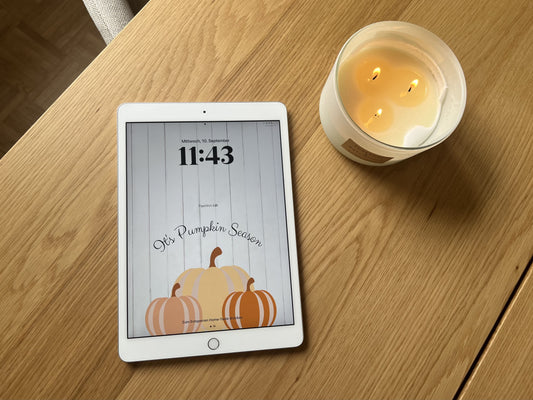You know that feeling? You buy yourself a beautiful new calendar, meticulously fill the first few pages with to-dos, and after a few weeks, it sits unused in a drawer. And then the guilt starts creeping in: "Why can't I stick to my plans? Why does it always seem so effortless for others?"
The good news: You're not alone. And even better: you're not the problem.
1. Why you are not the problem (but the method) 
We often blame ourselves when a planning attempt fails. But it's rarely a matter of our discipline, but usually a matter of the method. Paper is limited: no search function, no flexible customization, no room for experimentation. A digital system, on the other hand, grows with you, adapts to your daily routine, and can actually be fun – instead of overwhelming.
I know this only too well: Since I'm quite a perfectionist myself, planning on paper often took more time than it gave me. One small typo and I wanted to redo the whole page. An appointment would get moved, and my subconscious would practically rebel against crossing it out. Even though I was initially full of motivation and entered everything neatly, I quickly realized: In everyday life, this simply wasn't practical for me. I needed a system that would allow me to flexibly reschedule appointments without feeling like my calendar was getting messy. A system where a mistyped word would simply be deleted instead of forcing me to start over. And I finally wanted to have my notes clearly organized in one place... without a clutter of paper!
At some point, I honestly asked myself, " Why don't I look at my analog planner anymore, at least not after March?" The answer quickly became clear: It simply wasn't my system.
2. Our aha moments
We regularly receive messages from customers who describe their “aha” moments with digital planning: 
Time and again, we read in the reviews statements like, "I'm finally really sticking with it – because it's simply fun!" or how much they love the mix of technical possibilities and creative design. Many also say they were surprised at how easy the transition was. And this despite having no previous contact with digital planning!
But why is that? It was precisely this aspect—the fun of digital planning —that piqued my curiosity. I wanted to find out what was behind it and took a scientific look at the whole thing.
3. Scientifically sound: 5 reasons for digital planning
So why does digital planning make so much sense… and even make you happy? Scientific studies provide fascinating answers:
More motivation through the gamification effect
When we visualize progress, our brain releases happy hormones. This applies not only to games, but also to our daily planning. Completed tasks, small stickers, or colored markers act as small rewards that activate our reward system and motivate us to keep going. 
Less stress through better organization
Digital systems help us structure tasks more realistically, set clear priorities, and stay on top of deadlines. Studies show that such a structure in everyday life lowers perceived workload and reduces stress.
Flexibility instead of rigidity
While a paper planner is fixed, digital lists and calendars can be adjusted at any time. Appointments can be moved, tasks rearranged, and content added – all without creating chaos on the page. This flexibility demonstrably increases the likelihood of sticking with it in the long term.
Handwriting meets technology
Another important point: Handwriting supports memory and creativity. Studies show that handwritten notes help us process content more deeply. Using a tablet, we combine this advantage with digital capabilities: we write by hand and simultaneously benefit from search functions, zoom, copy, and move.

Sustainability as extra motivation
And don't forget: Planning digitally saves paper. This is not only practical because it eliminates paperwork, but also reduces resource consumption and protects the environment.
And I've observed all of this myself. I love designing my planner pages in the Gamechanger with colors and stickers. This makes planning not only clear but also creative. As an absolute to-do list fan, I enjoy every single "I did it!" feeling when I check things off. At the same time, I'm much more organized today: Appointments can be flexibly moved without creating chaos in the planner. And my handwriting is preserved, with the advantage that it can even be neatly converted if necessary. Perfect for my slight tendency toward perfectionism. 😉
4. Getting started: Why the tablet is the optimal replacement
Tablet + pen + note-taking app = your digital superpower. 
The iPad or a comparable tablet forms the perfect interface between analog writing and digital convenience. You get the tactile feel of writing, complemented by features like zoom, copy & paste, hyperlinks, and stickers. In short, everything you need to make your everyday planning easier without sacrificing the feeling of writing.
My top advantages of digital planning:
✅ Appointments can be moved flexibly without pages appearing messy.
✅ Misspelled words can be easily deleted or converted: no rewriting necessary.
✅ Everything is in one place: notes, lists, sketches and appointments – without paper chaos.
✅ Creative design with stickers, colors and symbols makes planning more motivating.
✅ Everything is always at hand and available synchronously on multiple devices.
This turns your tablet into not just a replacement for paper, but a real game changer for your organization!
5. The switch in simple steps
Many people ask us: “How do I finally manage to plan digitally?” The simple answer: Like any new habit: with time and patience.
The brain loves routine. And that's precisely why it's difficult for us to swap the pen for the tablet at first. But after about 66 days (the average time for new habits), reaching for the iPad becomes as natural as reaching for paper. 
Ask yourself these three questions:
-
Why do I want to plan digitally?
-
Which areas do I want to plan digitally?
-
What technical equipment do I need?
To make getting started as easy as possible, we have a dedicated section on the blog with beginner tips . There you'll find everything about Goodnotes, iPad, and more. We'll show you how to master the transition step by step!
6. Your next step 
If you're now curious about digital planning but still not quite sure, I have a tip for you: You can find free test planners on our website! Simply download them and try them out for yourself to see if you enjoy digital planning as much as we do – completely risk-free.
7. Conclusion: No more guilt, bring on moments of success
The real aha moment is: You aren't the problem. Your method was.
Digital planning combines the best of both worlds: the flexibility and efficiency of technology with the feel of paper. It not only makes planning more manageable— it also finally makes planning motivating and fun again.
That's exactly what I've noticed in myself: Since I started planning digitally, I've finally been able to stick to it for the long term and enjoy actually following through with my plans.
Be sure to try it out for yourself and get our test planner:
To the free test planner To the free test planner




